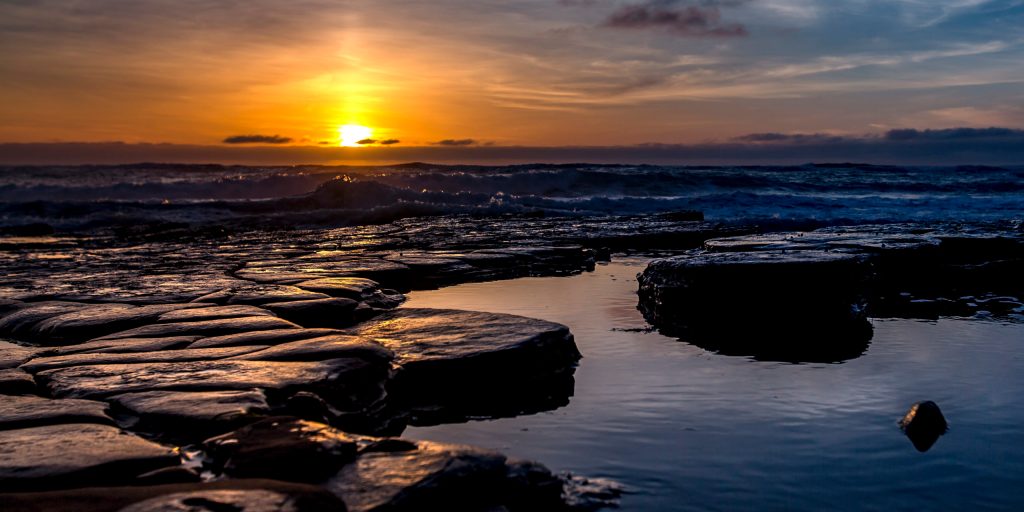Your Complete Guide to San Diego’s Tide Pools

Tide pools are one of Earth’s most fascinating and delicate ecosystems. Here in San Diego, there are a plethora of beautiful tide pools, making yet another reason as to why a trip down to the city should be a top priority. Before visiting, however, remember how crucial it is to keep the environment and its organisms safe. Read on to learn more about tide pools and why they are definitely worth seeing.
Why Tide Pools Are So Important
Tide pools are formed during the ocean’s tidal cycles. When the tide comes through, small pockets of water reside in depressions throughout the intertidal zone, forming the pools. During this process, many different organisms are carried through the tide and get caught within the tide pools. The tide pools not only become these creatures’ homes, but a fantastic feeding ground for predators. Sea birds, crabs, and others search through the pools for their next meal. Disrupting tide pools in any way is disrupting the circle of life.
Best Time of Day to Visit Tide Pools
In California, due to the gravitational pull of the sun and moon, there are two high tides and two low tides per day. When it comes to tide pools, you will always want to go when the ocean’s tides are at their lowest. Negative low tides are ideal, found in the mornings during the spring and during the afternoon come late fall/winter. When the tide begins to recede, the rocks along the shoreline are exposed, filled with the trapped water. Inside you will find the thriving habitat of many living organisms. *It is advised that you check out a local tide chart when choosing what time to visit. Be sure to keep an eye on the tide while you are looking at the tidepools as the water level can change rapidly if you aren’t paying attention.
What Kind of Animals Live In Tide Pools?
There are many different organisms that live within tide pools and the adaptation of each is truly remarkable. Surviving the waves turbulence, predation, and competition for space and water are a few of the endurances these creatures have to face. Some of the impressive organisms you will find are sea stars, sea urchins, sea cucumbers, barnacles, and anemones. As well, the Pacific octopus has made its home within tide pools. Unlike squid, they reside in rocks and caves, rather than the open sea.
Animal Safety
Although it can be tempting for kids to pick up and play with the various living organisms in the tide pools, please educate your children about the power of observation. We can learn so much from these animals by simply observing their movements. Animals can be harmed if we pick them up and attempt to play with them like toys. Please refrain from picking up starfish or putting your fingers inside the mouth of a sea anemone. Sea urchins can sting and crabs have powerful claws! It’s best to simply observe and watch the animals in this incredible ecosystem while keeping everyone safe.
Tidepool Exploration In San Diego
Walking down the beaches of San Diego you will find a variety of different tide pools to explore. Tide is relatively low during the daylight hours of November-March, which is beneficial for those looking to visit these habitats. Some popular tide pools in SD can be found at the Cabrillo National Monument Tide Pools, Sunset Cliffs Natural Park, Dike Rock Tide Pools, Birch Aquarium At Scripps, and Cardiff State Beach (to name a few). No matter which location you choose to visit, you will leave in awe at yet another one of Earth’s fascinating creations.
San Diego’s Best Tide Pools
Along the west coast there are a ton of tide pools, but nothing quite compares to those of San Diego.
Cabrillo National Monument Tide Pools – The Cabrillo National Monument is a top location for tide pool explorers; over 350,000 people visit a year! The best time to visit is in the fall and winter months during low tide.
Sunset Cliffs National Park – Sunset Cliffs is well known for its surfing, but it’s also a hidden gem for tide pools. There is a staircase that leads directly down to the large flat area where the tide pools are located. The area is extremely flat and is typically only hit by mid to low tide. We recommend venturing to the northern area where tide pools are most ideal due to the rock formations.
Dike Rock Tide Pools – Although this location isn’t as large as the others, there are variations in regions that provide a larger array of marine life to observe. For example, there are large boulders along the edges for creatures to rest on that do not prefer rough water and in the south there is more land but less rocks for those that enjoy the sand.
Birch Aquarium At Scripps – The Birch Aquarium has a Tide Pool Plaza, which is the home to one of the most gorgeous tide pools as it overlooks La Jolla. Although not a natural tide pool, this man-made tide pool is extremely accurate to what you would find below on the sand.
Cardiff State Beach – The tide pools at Cardiff State Beach are located just south of the beach’s parking lot. Fun fact: it contains 45 million year old rocks with clam fossils!
